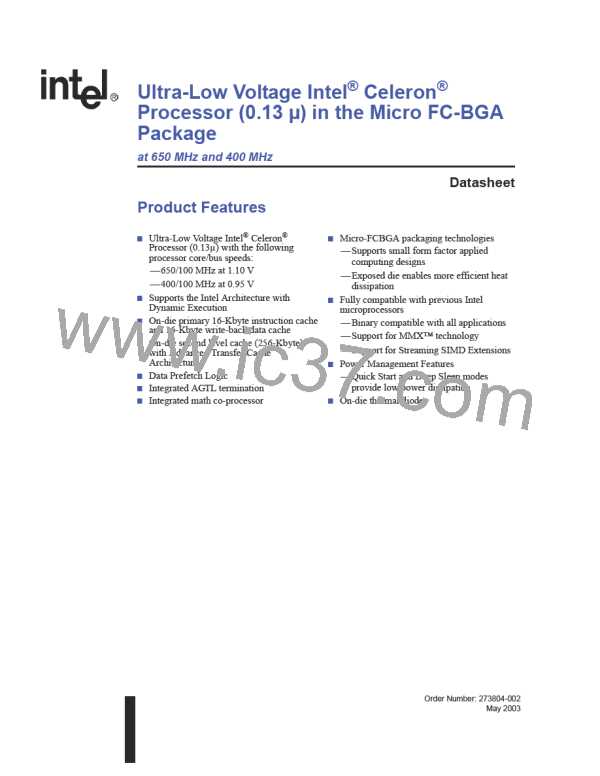Ultra-Low Voltage Intel® Celeron® Processor — 650 MHz and 400 MHz
8.1.27
IERR# (O - 1.5 V Tolerant Open-drain)
The IERR# (Internal Error) signal is asserted by the processor as the result of an internal error.
Assertion of IERR# is usually accompanied by a SHUTDOWN transaction on the system bus. This
transaction may optionally be converted to an external error signal (e.g., NMI) by system logic.
The processor will keep IERR# asserted until it is handled in software or with the assertion of
RESET#, BINIT, or INIT#.
8.1.28
8.1.29
IGNNE# (I - 1.5 V Tolerant)
The IGNNE# (Ignore Numeric Error) signal is asserted to force the processor to ignore a numeric
error and continue to execute non-control floating-point instructions. If IGNNE# is deasserted, the
processor freezes on a non-control floating-point instruction if a previous instruction caused an
error. IGNNE# has no affect when the NE bit in control register 0 (CR0) is set.
INIT# (I - 1.5 V Tolerant)
The INIT# (Initialization) signal is asserted to reset integer registers inside the processor without
affecting the internal (L1 or L2) caches or the floating-point registers. The processor begins
execution at the power-on reset vector configured during power-on configuration. The processor
continues to handle snoop requests during INIT# assertion. INIT# is an asynchronous input.
If INIT# is sampled active on RESET#'s active-to-inactive transition, then the processor executes
its built-in self-test (BIST).
8.1.30
8.1.31
INTR (I - 1.5 V Tolerant)
The INTR (Interrupt) signal indicates that an external interrupt has been generated. INTR becomes
the LINT0 signal when the APIC is enabled. The interrupt is maskable using the IF bit in the
EFLAGS register. If the IF bit is set, the processor vectors to the interrupt handler after completing
the current instruction execution. Upon recognizing the interrupt request, the processor issues a
single Interrupt Acknowledge (INTA) bus transaction. INTR must remain active until the INTA
bus transaction to ensure its recognition.
LINT[1:0] (I - 1.5 V Tolerant)
The LINT[1:0] (Local APIC Interrupt) signals must be connected to the appropriate pins/balls of
all APIC bus agents, including the processor and the system logic or I/O APIC component. When
APIC is disabled, the LINT0 signal becomes INTR, a maskable interrupt request signal, and
LINT1 becomes NMI, a non-maskable interrupt. INTR and NMI are backward compatible with the
same signals for the Pentium processor. Both signals are asynchronous inputs.
Both of these signals must be software configured by programming the APIC register space to be
used either as NMI/INTR or LINT[1:0] in the BIOS. If the APIC is enabled at reset, then
LINT[1:0] is the default configuration.
74
Datasheet

 INTEL [ INTEL ]
INTEL [ INTEL ]